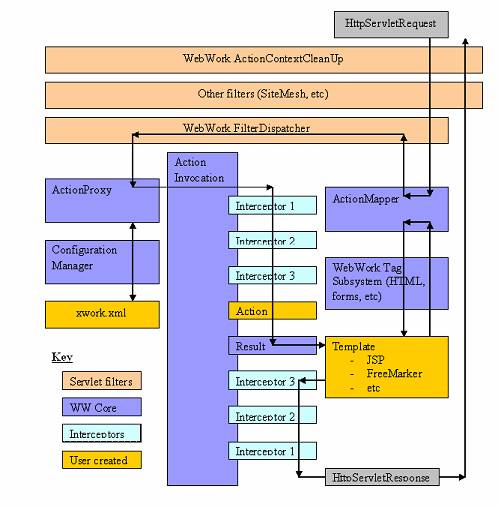您好,登錄后才能下訂單哦!
您好,登錄后才能下訂單哦!
本篇內容主要講解“WebWork的框架初始化過程和用戶請求處理過程”,感興趣的朋友不妨來看看。本文介紹的方法操作簡單快捷,實用性強。下面就讓小編來帶大家學習“WebWork的框架初始化過程和用戶請求處理過程”吧!
一、WebWork的框架初始化過程
WebWork做的項目,在服務器啟動時完成WebWork的框架初始化。具體是通過Web.xml中配置好的com.opensymphony.xwork.dispatcher.ServletDispatcher(FilterDispatcher)過濾器中的init(ServletConfig servletConfig)方法完成。
并且web.xml中配置好ServletDispatcher的映射,當用戶用映射好的結尾資源請求瀏覽器時,ServletDispatcher會進行請求處理(ServletDispatcher是一個HttpServlet)。
具體實現是通過以下步驟:
1、通過ServletDispatcher中的init方法進行框架的初始化工作:
public void init(ServletConfig servletConfig) throws ServletException { super.init(servletConfig); DispatcherUtils.initialize(getServletContext()); }2、init方法又同時調用DispatcherUtils類的initialize方法創建DispatcherUtils實例,同時間接調用DispatcherUtils類的init方法初始化Configuration配置,創建對象創建的工廠ObjectFactory和ObjectTypeDeterminer。
至此完成WebWork框架的初始化。
二、WebWork的用戶請求處理過程
所有以web.xml中映射ServletDispatcher結尾的服務請求將由ServletDispatcher進行處理。
1、從用戶請求的服務名中解析出對應Action的名稱。
public void service(HttpServletRequest request, HttpServletResponse response) throws ServletException { //.... try { request = du.wrapRequest(request, getServletContext()); } catch(IOException e) { String message = "Could not wrap servlet request with MultipartRequestWrapper!"; LOG.error(message, e); throw new ServletException(message, e); } du.serviceAction(request, response, getServletContext(), mapping); }2、遍歷HttpServletRequest、HttpSession、ServletContext 中的數據,并將其復制到Webwork的Map中,為下一步創建Action實例打下基礎。
實現:通過過調用DispatcherUtils的serviceAction方法中的Map extraContext = createContextMap(request, response, mapping, context);完成以上信息的封裝。
3、以上一步封裝好的信息為參數,調用ActionProxyFactory創建對應的ActionProxy實例。ActionProxyFactory 將根據Xwork 配置文件(xwork.xml)中的設定,創建ActionProxy實例,ActionProxy中包含了Action的配置信息(包括Action名稱,對應實現類等等)。
實現:通過ActionProxy proxy = ActionProxyFactory.getFactory().createActionProxy(namespace, name, extraContext, true, false);//創建動態代理DefaultActionProxyFactory實現ActionProxyFactory的createActionProxy方法,返回new DefaultActionProxy(namespace, actionName, extraContext, true, true);DefaultActionProxy是對ActionProxy的默認實現,通過DefaultActionProxy類的DefaultActionProxy(namespace, actionName, extraContext, true, true)構造方法實例化DefaultActionProxy,同時得到用戶請求的actionName及namespace,并通過config = ConfigurationManager.getConfiguration().getRuntimeConfiguration().getActionConfig(namespace, actionName);
ConfigurationManager的
public static synchronized Configuration getConfiguration() { if(configurationInstance == null) { configurationInstance = new DefaultConfiguration(); try { configurationInstance.reload(); } catch(ConfigurationException e) { configurationInstance = null; throw e; } } else { conditionalReload(); } return configurationInstance; }完成對xwork.xml(具體操作類是XmlConfigurationProvider)配置信息的讀取。獲得與此次請求相關的ActionConfig。
4、ActionProxy創建對應的Action實例,并根據配置進行一系列的處理程序。
通過DefaultActionProxy類的invocation = ActionProxyFactory.getFactory().createActionInvocation(this, extraContext);
//通過createActionInvocation方法創建動作調用類ActionInvocation,處理被Action調用的方法
privatevoid resolveMethod() { // if the method is set to null, use the one from the configuration // if the one from the configuration is also null, use "execute" if (!TextUtils.stringSet(this.method)) { this.method = config.getMethodName(); if (!TextUtils.stringSet(this.method)) { this.method = "execute"; } } }然后調用DispatcherUtils的serviceAction方法中的
if (mapping.getResult() != null) { Result result = mapping.getResult(); result.execute(proxy.getInvocation()); } else { proxy.execute(); }完成用戶的最終要執行的action方法。
public String execute() throws Exception { ActionContext nestedContext = ActionContext.getContext(); ActionContext.setContext(invocation.getInvocationContext()); String retCode = null; try { retCode = invocation.invoke(); } finally { if (cleanupContext) { ActionContext.setContext(nestedContext); } } return retCode; }最終處理ActionContext對象,將Action調用提交給ActionInvocation處理。
5、 一旦Action方法返回,ActionInvocation就要查找xwork.xml文件中這個Action的結果碼(Action Result Code)(一個String如success、input)所對應的result,然后執行這個result。通常情況下,result會調用JSP或FreeMarker模板來呈現頁面。當呈現頁面時,模板可以使用WebWork提供的一些標簽,其中一些組件可以和ActionMapper一起工作來為后面的請求呈現恰當的URL。
下面我們來看action部分的定義:
<action name="loginAction" class="loginAction"> <result name="success" type="dispatcher">/common/loginedHomeAction!init.action</result> </action>
這里的result結點有一個type屬性,這表示此action的結果應該怎樣處理。
再來看看dispatcher類型的result是怎么定義的:
<result-type name="dispatcher" class="com.opensymphony.webwork.dispatcher.ServletDispatcherResult" default="true"/>
到這里就可以知道了處理是交給ServletDispatcherResult類來做的。
ServletDispatcherResult類繼承了WebWorkResultSupport類,而WebWorkResultSupport實現了com.opensymphony.xwork.Result接口,此接口用來處理action的結果。WebWorkResultSupport類定義了一個抽象的方法——doExecute,此方法用于實現對Result的處理。
下面來看看ServletDispatcherResult是怎么處理的:
public void doExecute(String finalLocation, ActionInvocation invocation) throws Exception { PageContext pageContext = ServletActionContext.getPageContext(); if (pageContext != null) { pageContext.include(finalLocation); } else { HttpServletRequest request = ServletActionContext.getRequest(); HttpServletResponse response = ServletActionContext.getResponse(); RequestDispatcher dispatcher = request.getRequestDispatcher(finalLocation); // if the view doesn't exist, let's do a 404 if (dispatcher == null) { response.sendError(404, "result '" + finalLocation + "' not found"); return; } // If we're included, then include the view // Otherwise do forward // This allow the page to, for example, set content type if (!response.isCommitted() && (request.getAttribute("javax.servlet.include.servlet_path") == null)) { request.setAttribute("webwork.view_uri", finalLocation); request.setAttribute("webwork.request_uri", request.getRequestURI()); dispatcher.forward(request, response); } else { dispatcher.include(request, response); } } }我們看到,最終調用的是dispatcher.forward(request, response);這樣就可以成功轉到我們的目標頁了。
以下代碼為DispatcherUtils中的serviceAction方法中的:
public void serviceAction(HttpServletRequest request, HttpServletResponse response, ServletContext context, ActionMapping mapping) throws ServletException { Map extraContext = createContextMap(request, response, mapping, context); OgnlValueStack stack = (OgnlValueStack)request.getAttribute("webwork.valueStack"); if(stack != null) extraContext.put("com.opensymphony.xwork.util.OgnlValueStack.ValueStack", new OgnlValueStack(stack)); try { String namespace = mapping.getNamespace(); String name = mapping.getName(); String method = mapping.getMethod(); String id = request.getParameter("__continue"); if(id != null) { Map params = (Map)extraContext.get("com.opensymphony.xwork.ActionContext.parameters"); params.remove("__continue"); extraContext.put("__continue", id); } ActionProxy proxy = ActionProxyFactory.getFactory().createActionProxy(namespace, name, extraContext, true, false); proxy.setMethod(method); request.setAttribute("webwork.valueStack", proxy.getInvocation().getStack()); if(mapping.getResult() != null) { Result result = mapping.getResult(); result.execute(proxy.getInvocation()); } else { proxy.execute(); } if(stack != null) request.setAttribute("webwork.valueStack", stack); } catch(ConfigurationException e) { LOG.error("Could not find action", e); sendError(request, response, 404, e); } catch(Exception e) { String msg = "Could not execute action"; LOG.error(msg, e); throw new ServletException(msg, e); } }三、WebWork的執行流程圖

到此,相信大家對“WebWork的框架初始化過程和用戶請求處理過程”有了更深的了解,不妨來實際操作一番吧!這里是億速云網站,更多相關內容可以進入相關頻道進行查詢,關注我們,繼續學習!
免責聲明:本站發布的內容(圖片、視頻和文字)以原創、轉載和分享為主,文章觀點不代表本網站立場,如果涉及侵權請聯系站長郵箱:is@yisu.com進行舉報,并提供相關證據,一經查實,將立刻刪除涉嫌侵權內容。